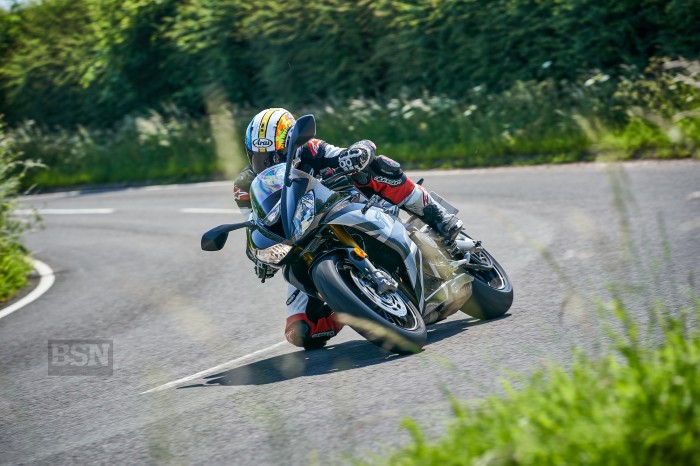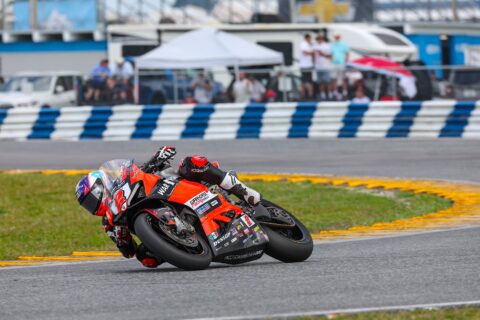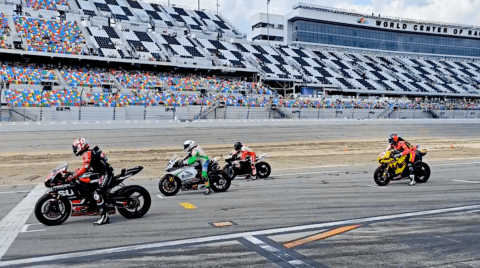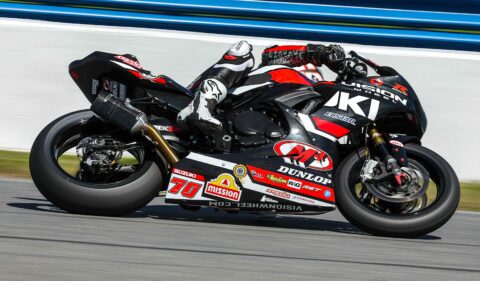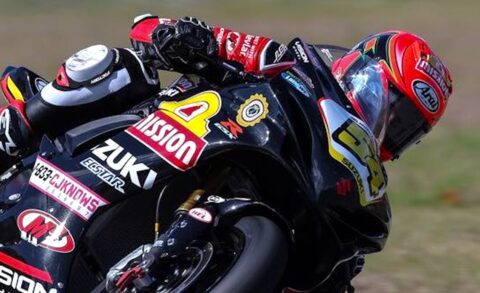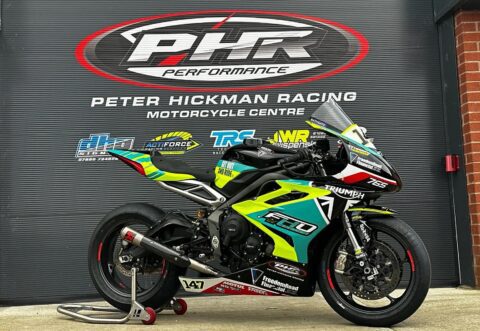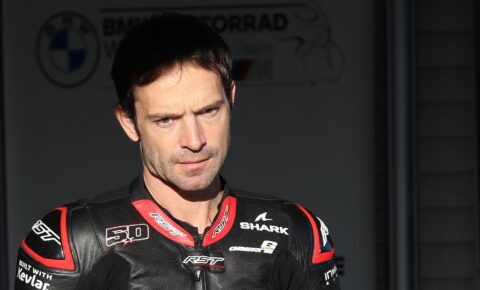To celebrate Triumph’s return to MotoGP as the engine supplier to Moto2, Triumph has, in its brilliant wisdom, produced a road-going version of their race bike. Sort of…
Its engine proudly carries the same logo and is the same capacity as the Moto2 bikes, but in fact the bike has more in common with Triumph’s super-popular Street Triple RS naked. Peak power is 128bhp, up from the Street’s 121bhp, thanks to a plethora of engine tweaks the team has carried over from the Moto2 engine.
These include titanium inlet valves, stronger pistons, MotoGP-spec DLC coated gudgeon pins, new cam profiles, new intake trumpets, plus modified con rods, intake port, crank and barrels, and an increased compression ratio.
Simply put, they have improved the flow, increased compression, and made the engine internals lighter to move faster. All of which allows the triple to sing, revving higher than the Street Triple RS engine by 600rpm, with the redline now at 13,250rpm. Peak torque is also up slightly, to 80Nm from 79Nm.
The chassis isn’t a Moto2 replica because that would be far too stiff for the road, and also frighteningly expensive. Instead, Triumph has fallen back on what they know by adopting the highly acclaimed 675R Daytona chassis.
Some might be perturbed by this, but the ‘R’ chassis was and arguably still is class-leading. In the UK, the chassis has proven its worth, taking three national championships and winning the 2019 Supersport TT with Peter Hickman at the helm.
To bring the package up to date for 2020, Triumph have chosen the very latest Öhlins suspension – NIX30 forks and a TTX36 rear shock – plus the hottest Stylema Brembo radial bakes. Tyres are sticky, track-focused Pirelli Supercorsa SP too.
Turn the key and the new colour instrument console comes alive with a pleasing graphical ‘Moto2’ start-up screen, before leading you into a familiar Triumph dash, now with five rider-mode options – Rain, Road, Rider Configurable, Sport and Track – all of which adjust the throttle map, traction control settings and ABS settings to the conditions and the way you ride.
There’s also an up-and-down quick-shifter with auto-blipper. The rider modes are not lean-sensitive, as there is no IMU, which means normal ABS braking and not corning ABS. Same with the traction control, which is not lean-sensitive but can be switched off.
Mode selected, a quick dab of the starter button and the Brit triple barks to life through its titanium Arrow end can. I love the growl and bark of a Triumph triple, and the new Daytona is one of the best sounding bikes in the Hinckley factory’s fleet. It sounds so sweet and charismatic, but not annoyingly loud, so sneaking out for an early morning ride without waking up the family shouldn’t be a problem.
Within just a few miles, I feel at home. I rated the old Daytona, and thankfully Triumph hasn’t moved too far away from a proven recipe. The fuelling at low speed is near-on perfect, the gears shift effortlessly, the quick-shifter and auto-blipper work perfectly.
Around town, at slow engine speeds, the power is smooth and there enough torque to let it burble along a gear too high. I don’t even need to slip the clutch away from the lights… Yes, for a Moto2-inspired rocket, it works in the real world too.
The chassis and Öhlins set up is, surprisingly, soft and plush, with speed humps and road imperfections easy on spine and wrists. Yes, the physical dimensions are on the small side; I’m only 5ft 7in and I make the bike appear ‘normal’. If you’re over six feet tall or opposed to exercise then you might find the Daytona too cramped.
But let’s forget about practicalities. Let’s tuck in behind that bubble and make this triple scream! Now we’re talking, this is what the bike was designed to do. Out in the lanes, dancing up and down on the quick-shifter, tucked in behind the screen, knee slider occasionally touching down on sun-drenched British roads… Hell yeah, this is brilliant. I’m in motorcycle heaven and this is why mid-size sportsbikes are so good.
The triple delivers more than enough mid-range torque to rapidly accelerate past slow-moving traffic; you only need to tap back one gear for a brisk overtake. But who wants brisk? That is like going to the pub and drinking sparkling ice water.
I want fun, which is why I opt to make the engine scream for sheer enjoyment.
Revving hard, into second gear, third and fourth – getting close to the redline, having ridiculous fun while still feeling in control. You’d never ride an unfamiliar B-road hard on a 1000cc production bike unless your name was John McGuinness, but you can on the Moto2 Daytona.
Make no mistake, it’s a super-quick bike but anything but intimidating, and a quick brush of the radial Brembo stoppers quickly brings the pace down to legal speeds should you spot the boys in blue in those small mirrors.
The lightweight chassis copes with everything I throw at it, from painfully bumpy unclassified roads taken at speed to humpbacked bridges that launch the Daytona into the unknown.
Again, like the engine, the suspension is there to be used and transmits perfectly to the rider what’s happening. The feel is excellent, the ride is plush, bordering on soft when pushed hard, but that might be down to my weight and aggressive riding.
The rear sits down more than expected when exiting slow corners hard on the power, and the manually adjustable suspension will need a tweak to reduce the laden sag a little before a trackday.
Overall, the set-up is forgiving and extremely stable for a short-wheelbase bike that allows you to ride with such confidence on unseen roads. The Daytona is accurate and easy to steer, lets you attack corners with confidence, and gives immense grip from its sticky Pirelli rubber.
It flicks between turns with ease, lets you carve up the lanes like an expert, and rolls over its 180 section rear effortlessly. The chassis flatters the rider, it’s that simple.
The Stylema Brembo stoppers are strong, it only takes one or two fingers on the span and ratio-adjustable lever to bring the dangerous-riding competition to a close.
The ABS is a little intrusive when you brake hard over imperfections, but this was only noticeable when I decided to turn into an Irish road racer for a brief moment. The lack of cornering ABS was never an issue, in fact, I spent most of the ride with the traction control deactivated to make the most of the Dayton’s other trick – wheelies ¬– which it does with nonchalant ease.
The old 675 Daytona loved a long and precise wheelie and, now with more torque, the new Daytona is more willing to loft the front wheel in the first few gears than ever.
Our test was blessed with the perfect weather and dry, warm roads. In fact, it was almost too hot at times, which is why the traction control was deactivated for most of the ride. With a manageable 95.6kW, perfect fuelling and feel from the sticky 180 rear Pirelli, I’d argue whether TC is even needed. However, in the colder, darker months I’ll certainly flick into rain mode, which reduces the power and adds more TC.
The Daytona isn’t going to be for everyone, and as a supersport fan I might be a tad biased. Yes, it is on the small side, while around town it will become a pain to live with. The mirrors aren’t the best, the switchgear is like jumping into a Porsche and finding it has VW switchgear.
There’s no room for a pillion, and we’ve not even mentioned the price. In the UK it’s nearly £16,000, which is a lot to ask, and nearly £6000 more than Triumph’s own Street Triple RS at £10,300 – and that is a bloody good bike.
If we look across the market, it’s seemingly not good news for Triumph. Kawasaki’s ZX-10R is cheaper at £14,499, and Ducati’s stunning Panigale V2 is £14,999. Ouch. But, in the Daytona’s defence, it’s good on fuel, has a decent tank range and is comfortable at speed while the ride is plush on the motorway. And who wants to take a pillion, anyway? They only upset the handling; get them to take the bus (and blame it on social distancing).
Verdict
The elephant in the room is the Daytona’s price. This is a special motorcycle, one dripping in carbon fibre and quality components with the cache of being a road-legal, limited edition Moto2 replica. I enjoyed thrashing Triumph’s Daytona, almost the perfect summer sportsbike for the road, and in that context it’s hard to fault.
How do you put a value on enjoyment? It does feel special and it is fun to ride. On some trackdays you might crave for more power, but everywhere else in the world, this poised, and beautifully built bike is more than enough. But please Triumph, can we have a non-carbon version with a slightly lower spec that brings it in at just a few bucks more than the Street RS?

